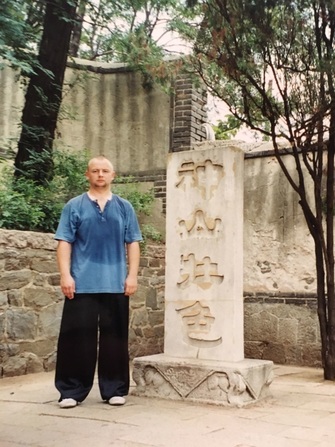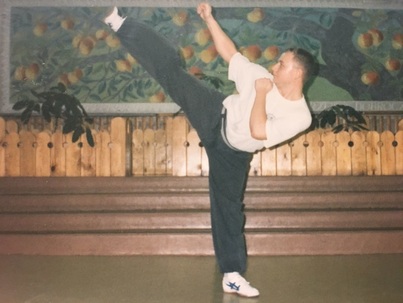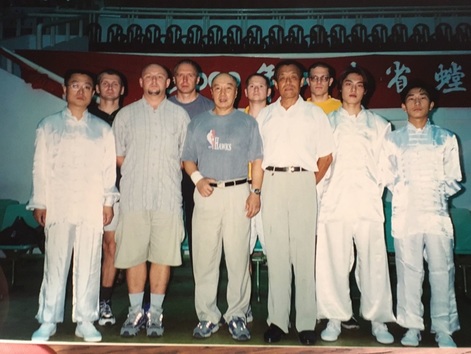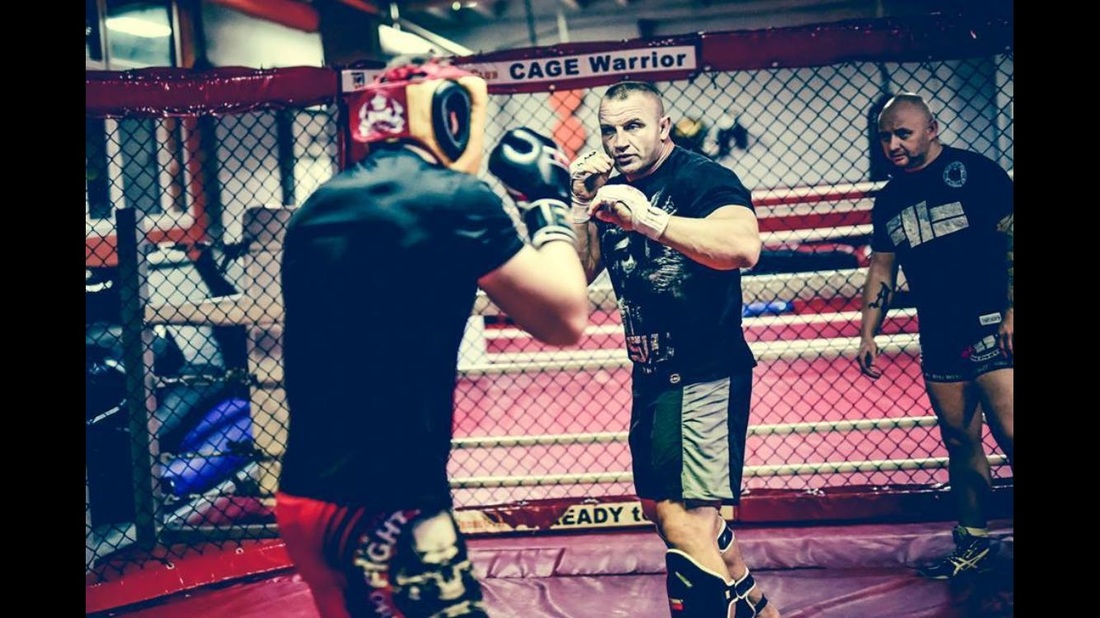Interview with Piotr Jeleniewski
In keeping with my penchant for interviewing figures of specific interest to myself, I am pleased to interview the founder and CEO of PJ Promotion Group and proud Yu family Qixing Tanglang representative, Brother Piotr Jeleniewski of Warsaw, Poland.
Piotr is an important figure in terms of Mantis Boxing’s position in the modern martial arts world. Coming from a strictly traditional background, he has straddled both the TCMA and combat sports worlds before embarking on a successful full-time career as an elite level professional MMA coach. Never losing sight of his Tanglang roots, Piotr has been afforded a valuable opportunity to view the art from a unique perspective – one which we are all likely to benefit from, should we open our minds a little. |
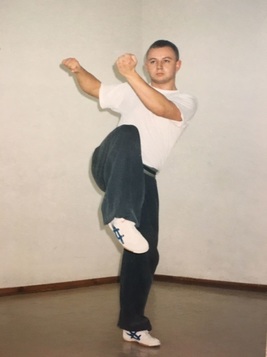
BT: Welcome bro!
Right from the start I should make it clear to our readers that I have a close personal connection with you. We first met in Qingdao in 2000 and have maintained regular contact since, including having the good fortune of staying with you on three occasions in Poland whilst a guest of the Polish Praying Mantis Kung Fu Federation. Although a good friend and Qixing Tanglang brother, it is for completely independent reasons that I chose to interview you. On top of that, I do so largely against your will, as I know that you don't consider yourself either a master of Mantis Boxing, nor do you seek notoriety or fame for your martial achievements. Thanks for sharing your time with us.
We should start way back in the Jurassic era when you first began to study martial arts. I believe Tanglang was your first love. Can you please tell us when you started training and the circumstances that lead you take it up?
PJ: So it was typical fat little loser story based on 'Enter the Dragon' movie. I was an 11 year old kid, crazy about martial arts and dreaming that one day I will knock down all these bully kids at school. Around 1986 Shifu Milczarek opened school in my neighborhood. After wearing my parents out pretending to be Bruce Lee at home they finally let me go - and I still remember my first lesson, because I was unable to move for a week due acidification of the muscle belly. But at least I found that I have muscles - which puzzled me for a long time... That was the start.
Ha ha, nice! I was a similar make and model - except I was pretending to be the Monkey King instead of Bruce Lee…
Was it unusual for a young lad in the working-class suburbs of Warsaw in the 80s to take up such a pursuit? How did your family and peers react?
It was time of economic and political changes in Poland, significantly affecting society. One of them was the ability to travel abroad (hard to believe these days). People started to travel and brought to Poland, amongst other things, martial arts knowledge. One of the CMA precursors was Sławomir Milczarek. For us it was a kind of magic world, hard to explain in the YouTube era. As an example, let me say that having black “kung fu” pants was like having a Rolex watch.
I still remember that we made up for a lack of knowledge and technique by hours of dedicated training of basics. My family was sure that I will drop training after a week, heavily injured and still fat.
We are certainly spoilt in this age of access to instant information at our fingertips. I believe the hunger exacerbated by this restricted access to material would have definitely contributed to your solid foundation.
Why not boxing or wrestling (arts you would later come to investigate in depth)? With Poland having such a strong wrestling culture, was gongfu looked upon strangely or regarded as ineffective for combat/self-defence?
Pure accident or like some say - destiny. Sławomir’s school was open next to my home, I was a kid and every other club, including boxing or wrestling, was too far away. At the same time my parents were too busy working - and of course, Bruce Lee’s impact was important too.
Destiny seems likely.
Speaking of Bruce Lee – he had an impact here too, though not as big as in many other countries. Although he was popular, it was mainly the ethnic kids that would emulate him in fighting, as kicking was deemed unacceptable in Australia until the 1980s. The first head kick knock out I saw was administered by a Laotian refugee, delivered with the trademark Bruce Lee scream...
Right from the start I should make it clear to our readers that I have a close personal connection with you. We first met in Qingdao in 2000 and have maintained regular contact since, including having the good fortune of staying with you on three occasions in Poland whilst a guest of the Polish Praying Mantis Kung Fu Federation. Although a good friend and Qixing Tanglang brother, it is for completely independent reasons that I chose to interview you. On top of that, I do so largely against your will, as I know that you don't consider yourself either a master of Mantis Boxing, nor do you seek notoriety or fame for your martial achievements. Thanks for sharing your time with us.
We should start way back in the Jurassic era when you first began to study martial arts. I believe Tanglang was your first love. Can you please tell us when you started training and the circumstances that lead you take it up?
PJ: So it was typical fat little loser story based on 'Enter the Dragon' movie. I was an 11 year old kid, crazy about martial arts and dreaming that one day I will knock down all these bully kids at school. Around 1986 Shifu Milczarek opened school in my neighborhood. After wearing my parents out pretending to be Bruce Lee at home they finally let me go - and I still remember my first lesson, because I was unable to move for a week due acidification of the muscle belly. But at least I found that I have muscles - which puzzled me for a long time... That was the start.
Ha ha, nice! I was a similar make and model - except I was pretending to be the Monkey King instead of Bruce Lee…
Was it unusual for a young lad in the working-class suburbs of Warsaw in the 80s to take up such a pursuit? How did your family and peers react?
It was time of economic and political changes in Poland, significantly affecting society. One of them was the ability to travel abroad (hard to believe these days). People started to travel and brought to Poland, amongst other things, martial arts knowledge. One of the CMA precursors was Sławomir Milczarek. For us it was a kind of magic world, hard to explain in the YouTube era. As an example, let me say that having black “kung fu” pants was like having a Rolex watch.
I still remember that we made up for a lack of knowledge and technique by hours of dedicated training of basics. My family was sure that I will drop training after a week, heavily injured and still fat.
We are certainly spoilt in this age of access to instant information at our fingertips. I believe the hunger exacerbated by this restricted access to material would have definitely contributed to your solid foundation.
Why not boxing or wrestling (arts you would later come to investigate in depth)? With Poland having such a strong wrestling culture, was gongfu looked upon strangely or regarded as ineffective for combat/self-defence?
Pure accident or like some say - destiny. Sławomir’s school was open next to my home, I was a kid and every other club, including boxing or wrestling, was too far away. At the same time my parents were too busy working - and of course, Bruce Lee’s impact was important too.
Destiny seems likely.
Speaking of Bruce Lee – he had an impact here too, though not as big as in many other countries. Although he was popular, it was mainly the ethnic kids that would emulate him in fighting, as kicking was deemed unacceptable in Australia until the 1980s. The first head kick knock out I saw was administered by a Laotian refugee, delivered with the trademark Bruce Lee scream...
 Yu Tiancheng's hands-on teaching method
Yu Tiancheng's hands-on teaching method
Not only did you take up Tanglang at a young age but you have maintained the practice for several decades. Obviously Tanglang is a system that is very well suited to you. No doubt the superior teaching methods of Master Sławomir Milczarek contributed to your long term dedication.
What kept you engaged for so long? Would you have stuck around as long if there was no emphasis on combat?
We had a tough crew in Sławomir’s school, some real guys who wanted to fight and some of them were very talented. However, around 1993 I was a bit disappointed by my experience out of school. I found out that some important tools were missing from the Hong Kong lineage we practiced. I started boxing in search of different footwork in sparring. Also, the focus on methods of knowledge-transfer was more suitable to the western mentality.
Luckily Sławomir met Master Yu Tiancheng and we started a new chapter - the chapter of real skills.
Of the many schools of TCMA that I have personally encountered, the Polish Praying Mantis Kung Fu Federation is definitely one that has long emphasised fighting. No doubt, as with my own school, the approach to developing these skills has evolved over time. What were your early experiences in this regard?
It was the primary and indeed only target for most of us – to learn how to fight. Not too much philosophy, verbal theory discussions. Most of us were looking for real tools, not an Asian-centric, cool, trendy hobby. It doesn't look the same anymore but maybe its signum temporis for CMA?
I remember Master Yu’s first visit to Poland. He showed some moves and I said that I thought it wouldn’t work in a real situation. He asked me to try with Him. He knocked me down. It was hand to hand teaching – no flowers, no bullshit. It was real gongfu.
Awesome! That’s pretty much the only kind of instruction I respond to as well.
I had a very honest and rare discussion with Yu Tiancheng Shifu during his last visit to Poland, about two years before he died. He told us some very important things that night – one of them was that the only reason why martial art should survive is utility. Anything else is only flowery, meaningless movements.
I'm not interested in bands of folk dances and I never was.
You were quite privileged to have had that conversation. It’s uncommon to hear such truths told by those in positions of authority in traditional martial arts. Some have too much to lose by cutting through the bullshit. On the other hand, there are those that say all the right things, but their material or teaching methods tell a completely different story.
What kept you engaged for so long? Would you have stuck around as long if there was no emphasis on combat?
We had a tough crew in Sławomir’s school, some real guys who wanted to fight and some of them were very talented. However, around 1993 I was a bit disappointed by my experience out of school. I found out that some important tools were missing from the Hong Kong lineage we practiced. I started boxing in search of different footwork in sparring. Also, the focus on methods of knowledge-transfer was more suitable to the western mentality.
Luckily Sławomir met Master Yu Tiancheng and we started a new chapter - the chapter of real skills.
Of the many schools of TCMA that I have personally encountered, the Polish Praying Mantis Kung Fu Federation is definitely one that has long emphasised fighting. No doubt, as with my own school, the approach to developing these skills has evolved over time. What were your early experiences in this regard?
It was the primary and indeed only target for most of us – to learn how to fight. Not too much philosophy, verbal theory discussions. Most of us were looking for real tools, not an Asian-centric, cool, trendy hobby. It doesn't look the same anymore but maybe its signum temporis for CMA?
I remember Master Yu’s first visit to Poland. He showed some moves and I said that I thought it wouldn’t work in a real situation. He asked me to try with Him. He knocked me down. It was hand to hand teaching – no flowers, no bullshit. It was real gongfu.
Awesome! That’s pretty much the only kind of instruction I respond to as well.
I had a very honest and rare discussion with Yu Tiancheng Shifu during his last visit to Poland, about two years before he died. He told us some very important things that night – one of them was that the only reason why martial art should survive is utility. Anything else is only flowery, meaningless movements.
I'm not interested in bands of folk dances and I never was.
You were quite privileged to have had that conversation. It’s uncommon to hear such truths told by those in positions of authority in traditional martial arts. Some have too much to lose by cutting through the bullshit. On the other hand, there are those that say all the right things, but their material or teaching methods tell a completely different story.
 With Masters Milczarek, Yu and Qixing brothers
With Masters Milczarek, Yu and Qixing brothers
Speaking of fighting (in all its forms – sparring, combat sports, self-defence, ritualized combat etc.), is this the essence of martial arts? Can one practice martial arts with no combat element?
It’s the only reason why martial arts were created. It’s very simple - for fighting. No combat element? No martial art. Practicing for tradition, keeping memories alive.... How can you respect tradition doing something ineffective and meaningless? It’s bullshit. All these internet wars about scrolls, lineages blah blah... Stand and fight - it will give you all the answers. This is the truth about martial arts. All the rest is a harbour for lying to oneself. Unfortunately, TCMA is a wide sea full of these kinds of harbours.
I couldn’t agree more. Of course, not everyone can, nor even wants to be a killing machine, and there certainly are more benefits to the practice of martial arts then just the development of fighting skills - however we’re fooling ourselves if we think they were devised for any other reason.
It’s the only reason why martial arts were created. It’s very simple - for fighting. No combat element? No martial art. Practicing for tradition, keeping memories alive.... How can you respect tradition doing something ineffective and meaningless? It’s bullshit. All these internet wars about scrolls, lineages blah blah... Stand and fight - it will give you all the answers. This is the truth about martial arts. All the rest is a harbour for lying to oneself. Unfortunately, TCMA is a wide sea full of these kinds of harbours.
I couldn’t agree more. Of course, not everyone can, nor even wants to be a killing machine, and there certainly are more benefits to the practice of martial arts then just the development of fighting skills - however we’re fooling ourselves if we think they were devised for any other reason.
 With the late Uncle Master Yu Tianlu
With the late Uncle Master Yu Tianlu
I recall reports of your first forays into combat sports, which I believe began with the study of wrestling during your time managing a Warsaw gym. Can you please tell us a little about how this came about and how it eventually led you into the MMA world?
Around 2006 I started to feel I needed to develop my knowledge and skills to make them more complete. I started to practice freestyle wrestling. I was always afraid of wrestlers due to a bad experience with one of them. Actually, he beat the shit out of me... So, I decided to learn how to wrestle, to know how to fight with a wrestler - and I fell in love with wrestling.
Nice. I have felt the helplessness of being dominated by a superior grappler and it’s kind of like being mauled by a sadistic gorilla…
Also, practicing western boxing and wrestling helped me a lot in understanding the principles of body work in Seven Star Praying Mantis, and CMA generally. Also, my roots from traditional training helped me a lot in wrestling – for example, center of gravity control developed by standing pole exercise was one example.
Around 2006 I started to feel I needed to develop my knowledge and skills to make them more complete. I started to practice freestyle wrestling. I was always afraid of wrestlers due to a bad experience with one of them. Actually, he beat the shit out of me... So, I decided to learn how to wrestle, to know how to fight with a wrestler - and I fell in love with wrestling.
Nice. I have felt the helplessness of being dominated by a superior grappler and it’s kind of like being mauled by a sadistic gorilla…
Also, practicing western boxing and wrestling helped me a lot in understanding the principles of body work in Seven Star Praying Mantis, and CMA generally. Also, my roots from traditional training helped me a lot in wrestling – for example, center of gravity control developed by standing pole exercise was one example.
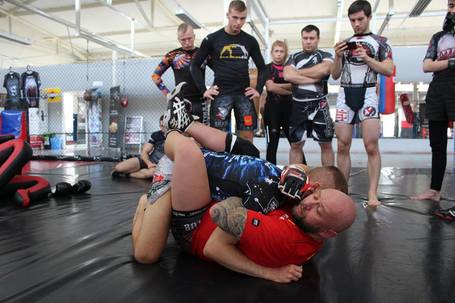 Master technician at work
Master technician at work
A few years before, I had seen VHS tapes with first UFC tournaments. I was delighted - pure fighting. That’s what I was looking for.
I was managing a Warsaw gym and had some friends who were experienced in different martial arts. We started to mix, one of us was BJJ practitioner, another, a national level title holding wrestler. It started in something of a ‘homemade’ fashion. It took a few years. We developed, learned and compared. And then accidentally, or by destiny, Maciej Górski KSW fighter came to the gym. He was working in the same building as the bodyguard of the office of the Israeli Consulate. Maciej was working out and saw a few of our training sessions then he asked if he could join us. I thought it would be cool to try and have one of best 70kg MMA fighters in Poland work together with us. He said we were doing pretty well and we could work together if we like - and that was my first step into MMA.
It seems that it was a good mix of hard work and fate. It could have just as easily gone nowhere.
I suspected MMA may be in your future after spending several hours with you dissecting footage of MMA bouts in your apartment during my first visit to Poland. Little did either of us know what the future would hold for you. I know that you’re a great fan of Lin Jingshan’s motto ‘Learning never ends’ (还得学). Was there a hunger to find answers, or were you on a quest for self-improvement?
I think both - to question myself and to develop. In fact, Lin’s motto is the answer. Yu Tiancheng said – ‘go out and test, take moves from others to improve yourself, don’t forget your roots, but develop’. Martial arts need to be alive. I try to follow him.
Very progressive and honest advice! Of course, intelligent fighters have been borrowing/stealing/emulating and customising technique and strategy for thousands of years, but it’s very refreshing to hear such advice from such a figure. So many people in the TMA world are obsessed with orthodoxy.
I was managing a Warsaw gym and had some friends who were experienced in different martial arts. We started to mix, one of us was BJJ practitioner, another, a national level title holding wrestler. It started in something of a ‘homemade’ fashion. It took a few years. We developed, learned and compared. And then accidentally, or by destiny, Maciej Górski KSW fighter came to the gym. He was working in the same building as the bodyguard of the office of the Israeli Consulate. Maciej was working out and saw a few of our training sessions then he asked if he could join us. I thought it would be cool to try and have one of best 70kg MMA fighters in Poland work together with us. He said we were doing pretty well and we could work together if we like - and that was my first step into MMA.
It seems that it was a good mix of hard work and fate. It could have just as easily gone nowhere.
I suspected MMA may be in your future after spending several hours with you dissecting footage of MMA bouts in your apartment during my first visit to Poland. Little did either of us know what the future would hold for you. I know that you’re a great fan of Lin Jingshan’s motto ‘Learning never ends’ (还得学). Was there a hunger to find answers, or were you on a quest for self-improvement?
I think both - to question myself and to develop. In fact, Lin’s motto is the answer. Yu Tiancheng said – ‘go out and test, take moves from others to improve yourself, don’t forget your roots, but develop’. Martial arts need to be alive. I try to follow him.
Very progressive and honest advice! Of course, intelligent fighters have been borrowing/stealing/emulating and customising technique and strategy for thousands of years, but it’s very refreshing to hear such advice from such a figure. So many people in the TMA world are obsessed with orthodoxy.
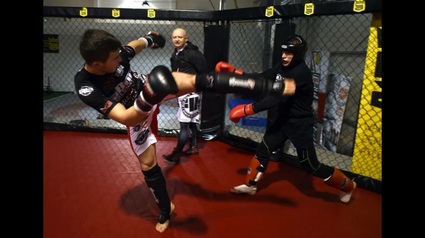
You have risen to great heights in the sport of MMA, not only as a coach, but also managing professional fighters of champion caliber.
You debuted as a professional MMA coach at Poland’s Konfrontacja Sztuk Walki (KSW) promotion in 2010, coaching Maciej Gorski to defeat Michal Mankiewicz by unanimous decision. You went on to coach, amongst others, Anzor Azhiev, Kuba Kowalewicz and legendary Polish strongman, Mariusz Pudzianowski – who under your guidance defeated Sean McCorkle, Oli Thompson, Pawel Nastula and Rolles Gracie. In your time in his camp Pudzianowski lost only to Aussie Peter Graham before the two of you went your separate ways.
Am I wrong in thinking that your success with Pudzianowski really brought your abilities to the public’s attention?
Yes, he is very famous person here - 5 times World Strongman Champ, TV Celebrity etc. So his activity brought a lot of noise and actually because of Mariusz’s involvement in MMA, this sport become popular in Polish mainstream media. The decision to work together was very hard, firstly because of his recognition and responsibilities. Secondly, because Strongman is completely different than MMA Fighter. The transition was a big challenge. Some people said it was not possible. I'm used to hearing 'not possible' directed to me, so I took it.
No doubt! I am sure you haven’t run from a challenge yet – including some of the greatest challenges a man can face.
(Note – Piotr has only recently been cleared after a long and hard battle with a life threatening form of cancer. All of this whilst simultaneously making some of the most significant leaps of progress in his professional and personal life).
You debuted as a professional MMA coach at Poland’s Konfrontacja Sztuk Walki (KSW) promotion in 2010, coaching Maciej Gorski to defeat Michal Mankiewicz by unanimous decision. You went on to coach, amongst others, Anzor Azhiev, Kuba Kowalewicz and legendary Polish strongman, Mariusz Pudzianowski – who under your guidance defeated Sean McCorkle, Oli Thompson, Pawel Nastula and Rolles Gracie. In your time in his camp Pudzianowski lost only to Aussie Peter Graham before the two of you went your separate ways.
Am I wrong in thinking that your success with Pudzianowski really brought your abilities to the public’s attention?
Yes, he is very famous person here - 5 times World Strongman Champ, TV Celebrity etc. So his activity brought a lot of noise and actually because of Mariusz’s involvement in MMA, this sport become popular in Polish mainstream media. The decision to work together was very hard, firstly because of his recognition and responsibilities. Secondly, because Strongman is completely different than MMA Fighter. The transition was a big challenge. Some people said it was not possible. I'm used to hearing 'not possible' directed to me, so I took it.
No doubt! I am sure you haven’t run from a challenge yet – including some of the greatest challenges a man can face.
(Note – Piotr has only recently been cleared after a long and hard battle with a life threatening form of cancer. All of this whilst simultaneously making some of the most significant leaps of progress in his professional and personal life).
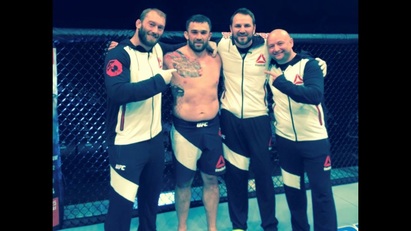 UFC victory with Daniel Omielańczuk
UFC victory with Daniel Omielańczuk
In recent times you have taken several Polish fighters to the UFC with a high success rate, with Daniel Omielańczuk, Marcin Tybura and Jan Błachowicz variously fighting on Fight Nights 84 (London), 86 (Zagreb), 91 (Sioux Falls), 92 (Salt Lake City), 93 (Hamburg) and UFC 204 in Manchester. It seems not long ago that there were almost no Poles in the UFC (apart from Krzysztof Soszyński), now several extremely talented fighters are filling the roster, including superstar Joanna Jedrzejczyk who is shining the light on Poland’s combat sports excellence.
How does it feel to be at the vanguard of this movement? You have been involved in the development of Polish MMA for a long time, so it must be an amazing feeling watching it all unfold.
I’m really happy that Polish fighters are proving how brave and tough our nation is. Through all historical turns, including bad times, we still keep - to use the Chinese expression – ‘hard fists and good hearts’.
Definitely!
I don’t think I can say I’m involved in the development of Polish MMA. There are big names here and I’m definitely not in this first line. I’m just part of this, doing my job.
Fair enough. You cannot deny though that you are amongst a small group at the forefront of bringing these fighters to international attention, particularly via success in the UFC. Then again, you would find a way to downplay it ;)
Although MMA and TCMA are two very different things, there are certainly areas of overlap - not only technically, but also strategically and for want of a better word, philosophically (yes, believe it or not combat sports are not totally devoid of thought or guiding principles). I know that you have a definite opinion in regards to the development of ‘gongfu’ via the practice of MMA and other combat sports. Although your path is different, is your ultimate goal the same as that of your martial forefathers?
It might sound strange, but after 30 years of practicing I feel like at the end of day different martial arts are just different ways to the same goal. There are always just two legs, two arms and a head. Some are more focused on legs, some more on hands, some just on bullshit.
At a certain level, you don’t see names of techniques or small details. You start to see the big picture and focus on the core. And regarding principles – in all you do in life you need to keep principles, not only in martial arts – no matter if TCMA, MMA, K1, TKD... Confucius said 'All coins are on one cord'.
How does it feel to be at the vanguard of this movement? You have been involved in the development of Polish MMA for a long time, so it must be an amazing feeling watching it all unfold.
I’m really happy that Polish fighters are proving how brave and tough our nation is. Through all historical turns, including bad times, we still keep - to use the Chinese expression – ‘hard fists and good hearts’.
Definitely!
I don’t think I can say I’m involved in the development of Polish MMA. There are big names here and I’m definitely not in this first line. I’m just part of this, doing my job.
Fair enough. You cannot deny though that you are amongst a small group at the forefront of bringing these fighters to international attention, particularly via success in the UFC. Then again, you would find a way to downplay it ;)
Although MMA and TCMA are two very different things, there are certainly areas of overlap - not only technically, but also strategically and for want of a better word, philosophically (yes, believe it or not combat sports are not totally devoid of thought or guiding principles). I know that you have a definite opinion in regards to the development of ‘gongfu’ via the practice of MMA and other combat sports. Although your path is different, is your ultimate goal the same as that of your martial forefathers?
It might sound strange, but after 30 years of practicing I feel like at the end of day different martial arts are just different ways to the same goal. There are always just two legs, two arms and a head. Some are more focused on legs, some more on hands, some just on bullshit.
At a certain level, you don’t see names of techniques or small details. You start to see the big picture and focus on the core. And regarding principles – in all you do in life you need to keep principles, not only in martial arts – no matter if TCMA, MMA, K1, TKD... Confucius said 'All coins are on one cord'.
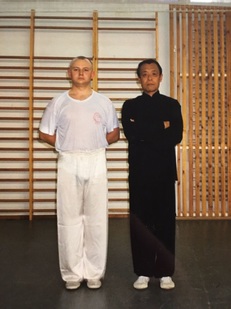 With the late Master Yu Tiancheng
With the late Master Yu Tiancheng
Your traditional foundations are deep, having focused exclusively on the practice of Qixing Tanglang Quan for several decades. Not only being blessed with the guidance of a great and progressive teacher in Master Sławomir Milczarek, you have also been fortunate enough to have studied directly with the late Master Yu Tiancheng on several occasions.
What impact have both teachers had on your development and what are the key lessons you have taken from your traditional training?
“No bullshit... “
There you have it! Short but sweet - kind of like you ;)
I know that you have successfully injected a few Tanglang/TCMA elements into your coaching. Can you elaborate on this?
As I said, in my opinion at a certain level everything becomes one – it’s like gongfu - skill achieved with work and time. However, some methods can be more effective than others. What I like to use in MMA taken from TCMA is the generation of short power methods during ground and pound, some hammer fist and elbow strikes too. Also, kicking without excessive hip rotation, which helps protect against wrestling counters. There are plenty of useful methods worth taking from TCMA, I think.
No doubt. As long as they are trained correctly, they can be effective. Personally, I jump out of my skin every time a see what is generally considered a ‘traditional’ method applied in MMA or any other combat sport. At the same time, I laugh my head off when commentators lose their minds over something like a front kick to the face or side kick to the body…
Speaking of your ability to bring these methods to the table - the most obvious thing that comes to mind was Daniel Omielańczuk’s repeated and effective use of furen jiao (斧刃脚) against Jarjis Danho (UFC Fight Night 84), but I’ve also seen you directly employ classic limb control methods (such as ‘sealing’) during grappling and ground and pound. In no way am I implying that you are training your fighters in Mantis Boxing, however I believe it may be impossible for you to completely wash the mantis off your bones and some of this may rub off on your boys from time to time.
If you see this it makes me happy. Some people say I betrayed Mantis Boxing, but it’s not true. 'Learning never ends'. I work on my Mantis Boxing every single day.
In truth, I think you are closer to the essence than most. If Mantis Boxing can be betrayed (which is of course a ridiculous idea) then this is far from how to do it. It certainly can be and frequently is - butchered, reconstituted, repackaged and pimped like a cheap whore by those who never worked hard enough understand it in the first place – but that’s another matter…
I have trained with you in the past, plus seen you in action long before that. I am glad I only ‘played’ with you before you had further honed your skills by thousands of hours of striking, grappling and holding pads for many vicious heavyweight monsters. Even back then, you had blinding speed and snake-like reactions. Although you could have been champion material had you gone down the competition path yourself, in my opinion you are even better suited for good old fashioned dirty street violence.
How much of this is down to good genes, combined with hard training and how much of it is down to growing up in a tough Warsaw neighbourhood?
You are far too kind. I have still scars on head after our friendly exchange years ago.
I still have scars on my ego for trying to choke you with all of my strength for about 5 minutes and you laughing at me like I was a small girl, ha ha…
It’s hard to say about myself, but I saw my father fighting in the street when I was a kid, aged around 7 or 8 years. My neighbourhood wasn’t, let me say - attractive. I was robbed by much older boys once, after few months I saw one of them when I was with my Dad and Uncle doing weekend shopping. I told him this guy robbed me. He was an approximately 16 year old gang member. So, my Dad took me to him, smashed his face and asked is he still so brave to rob and beat a child. Then we went to the grocery shop, we finished and left. Outside were gang members waiting – about 6 guys around 18-20 years old. I never saw my Dad before or after like this again. He literally went into Berserker mode! I knew he was tough when he was young, but I saw a bull with bloody eyes. It was a very entertaining morning. After all this my Dad and Uncle looked very happy and enjoyed the bruises and blood. We needed to do a little more shopping as some glass bottles of water were used...
Somehow I think I’m close to my Father. The rest you can learn, but this you need to have inside - given by accident or destiny... or God.
That would be etched on your soul for sure. Some people are traumatized by such situations, but others cherish them as golden memories (what’s wrong with us?!) Fortunately, there will be no need for your kids to see you in a similar situation as they have grown up alongside you in the gym and already know what their dad is capable of.
What impact have both teachers had on your development and what are the key lessons you have taken from your traditional training?
“No bullshit... “
There you have it! Short but sweet - kind of like you ;)
I know that you have successfully injected a few Tanglang/TCMA elements into your coaching. Can you elaborate on this?
As I said, in my opinion at a certain level everything becomes one – it’s like gongfu - skill achieved with work and time. However, some methods can be more effective than others. What I like to use in MMA taken from TCMA is the generation of short power methods during ground and pound, some hammer fist and elbow strikes too. Also, kicking without excessive hip rotation, which helps protect against wrestling counters. There are plenty of useful methods worth taking from TCMA, I think.
No doubt. As long as they are trained correctly, they can be effective. Personally, I jump out of my skin every time a see what is generally considered a ‘traditional’ method applied in MMA or any other combat sport. At the same time, I laugh my head off when commentators lose their minds over something like a front kick to the face or side kick to the body…
Speaking of your ability to bring these methods to the table - the most obvious thing that comes to mind was Daniel Omielańczuk’s repeated and effective use of furen jiao (斧刃脚) against Jarjis Danho (UFC Fight Night 84), but I’ve also seen you directly employ classic limb control methods (such as ‘sealing’) during grappling and ground and pound. In no way am I implying that you are training your fighters in Mantis Boxing, however I believe it may be impossible for you to completely wash the mantis off your bones and some of this may rub off on your boys from time to time.
If you see this it makes me happy. Some people say I betrayed Mantis Boxing, but it’s not true. 'Learning never ends'. I work on my Mantis Boxing every single day.
In truth, I think you are closer to the essence than most. If Mantis Boxing can be betrayed (which is of course a ridiculous idea) then this is far from how to do it. It certainly can be and frequently is - butchered, reconstituted, repackaged and pimped like a cheap whore by those who never worked hard enough understand it in the first place – but that’s another matter…
I have trained with you in the past, plus seen you in action long before that. I am glad I only ‘played’ with you before you had further honed your skills by thousands of hours of striking, grappling and holding pads for many vicious heavyweight monsters. Even back then, you had blinding speed and snake-like reactions. Although you could have been champion material had you gone down the competition path yourself, in my opinion you are even better suited for good old fashioned dirty street violence.
How much of this is down to good genes, combined with hard training and how much of it is down to growing up in a tough Warsaw neighbourhood?
You are far too kind. I have still scars on head after our friendly exchange years ago.
I still have scars on my ego for trying to choke you with all of my strength for about 5 minutes and you laughing at me like I was a small girl, ha ha…
It’s hard to say about myself, but I saw my father fighting in the street when I was a kid, aged around 7 or 8 years. My neighbourhood wasn’t, let me say - attractive. I was robbed by much older boys once, after few months I saw one of them when I was with my Dad and Uncle doing weekend shopping. I told him this guy robbed me. He was an approximately 16 year old gang member. So, my Dad took me to him, smashed his face and asked is he still so brave to rob and beat a child. Then we went to the grocery shop, we finished and left. Outside were gang members waiting – about 6 guys around 18-20 years old. I never saw my Dad before or after like this again. He literally went into Berserker mode! I knew he was tough when he was young, but I saw a bull with bloody eyes. It was a very entertaining morning. After all this my Dad and Uncle looked very happy and enjoyed the bruises and blood. We needed to do a little more shopping as some glass bottles of water were used...
Somehow I think I’m close to my Father. The rest you can learn, but this you need to have inside - given by accident or destiny... or God.
That would be etched on your soul for sure. Some people are traumatized by such situations, but others cherish them as golden memories (what’s wrong with us?!) Fortunately, there will be no need for your kids to see you in a similar situation as they have grown up alongside you in the gym and already know what their dad is capable of.
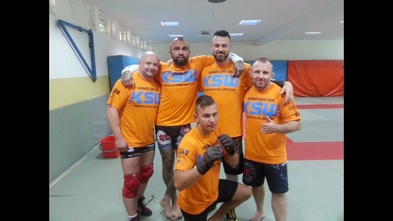
Although now most readily identified as a pro MMA coach, in a world where many may not even know your background (though you certainly never hide it), you are in fact a superior exponent of the practice and performance of taolu – winning the Gold Medal in the 2000 Qingdao International Wushu Championships with a beautiful, lightning-quick Bai Yuan Tou Tao (白猿偷桃) that got the attention of all in attendance.
Competition aside, what is your opinion of the practice of taolu? What is the value of forms practice (if any) and how should they be trained?
I follow Master Yu. In his opinion if student wants to learn how to fight only, you should give him 2-3 forms fixed to him. Give him some basic footwork and moves, plus some additional form especially suitable for him – e.g. tall person with long range techniques, or solid framed person with short range techniques – that gives him the tools that work for him. We have all of this in Mantis Boxing, which in fact is the MMA of TCMA. Then he can go for basic exercise in pairs, including hardening methods - following that, the 3 step system of fighting methods. Usually it should take about 3 years to obtain basic knowledge of barehand fighting with Seven Star Mantis. More-or-less, forms are the same as the shadow boxing methods of western boxing - as simple as that. So, forms are just part of the method, without the rest it’s just empty movements.
Which are your favourite forms and why? Have you achieved measurable benefits from the practice of taolu?
Shi Ba Suo (十八梭)
Bai Yan Tou Tao (白猿偷桃), Xian Tao (献桃) and Chu Dong (出洞)
San Lu Zhaiyao (三路摘要)
Forms are an important part of training helping primarily to develop muscle memory, generating proper body work and footwork. They are very important, if they are understood and performed correctly.
Competition aside, what is your opinion of the practice of taolu? What is the value of forms practice (if any) and how should they be trained?
I follow Master Yu. In his opinion if student wants to learn how to fight only, you should give him 2-3 forms fixed to him. Give him some basic footwork and moves, plus some additional form especially suitable for him – e.g. tall person with long range techniques, or solid framed person with short range techniques – that gives him the tools that work for him. We have all of this in Mantis Boxing, which in fact is the MMA of TCMA. Then he can go for basic exercise in pairs, including hardening methods - following that, the 3 step system of fighting methods. Usually it should take about 3 years to obtain basic knowledge of barehand fighting with Seven Star Mantis. More-or-less, forms are the same as the shadow boxing methods of western boxing - as simple as that. So, forms are just part of the method, without the rest it’s just empty movements.
Which are your favourite forms and why? Have you achieved measurable benefits from the practice of taolu?
Shi Ba Suo (十八梭)
Bai Yan Tou Tao (白猿偷桃), Xian Tao (献桃) and Chu Dong (出洞)
San Lu Zhaiyao (三路摘要)
Forms are an important part of training helping primarily to develop muscle memory, generating proper body work and footwork. They are very important, if they are understood and performed correctly.

Are there any traditional skills that you have shared with your fighters that have really surprised them or made an impact?
Sometimes they are surprised when hitting my forearms or when I hit them with my body. Mostly they are surprised when I accelerate. They say I should stop then... because I’m too old and I will fall apart. Definitely they are modern fighters with a traditional sense of humor.
Ha ha, nice one! Yeah, without a doubt you are conditioned to the point of becoming rock. I didn’t say anything at the time, but you cracked a chunk out of my forearm in 2007. Thanks for helping to develop my elbow defence ;)
What is the modern training method or approach that you feel has best sharpened your Tanglang skills. Are there any methods that we could adopt to develop Mantis Boxing attributes or improve combat effectiveness?
Padwork and some wrestling methods in pairs which let you feel the opponent’s body and take control. They can be useful I think.
Definitely.
Sometimes they are surprised when hitting my forearms or when I hit them with my body. Mostly they are surprised when I accelerate. They say I should stop then... because I’m too old and I will fall apart. Definitely they are modern fighters with a traditional sense of humor.
Ha ha, nice one! Yeah, without a doubt you are conditioned to the point of becoming rock. I didn’t say anything at the time, but you cracked a chunk out of my forearm in 2007. Thanks for helping to develop my elbow defence ;)
What is the modern training method or approach that you feel has best sharpened your Tanglang skills. Are there any methods that we could adopt to develop Mantis Boxing attributes or improve combat effectiveness?
Padwork and some wrestling methods in pairs which let you feel the opponent’s body and take control. They can be useful I think.
Definitely.
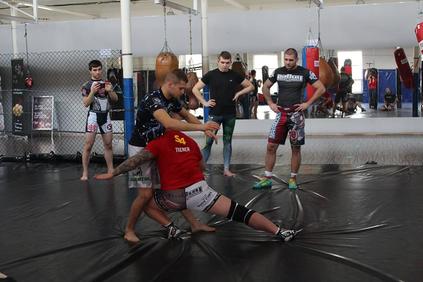
Are you a fan of weapons practice or do you prefer to focus on bare-hand combat methods? Which weapons do you like to practice?
In these times training with weapons is a useful method of developing dynamic power - for example halberd. For developing long, wide, body work – sabre. For generating power – spear. Developing coordination – sword. I like Yanqing Dao (燕青刀 and Chunqiu Dadao (春秋大刀). Tanglang Shuang Shou Jian (螳螂双手剑) is cool too.
What are your favourite/’go to’ techniques from Mantis Boxing? Are there any techniques you can occasionally pull off against unsuspecting fighters and consistently catch them by surprise?
Let me try to keep them a surprise ;)
OK, you passed the test. However, this means we will probably be safest using a Glock against you.
Speaking of the Glock, personally I prefer the 19 Gen4, but I’m a big fan of H&K USP ;)
In these times training with weapons is a useful method of developing dynamic power - for example halberd. For developing long, wide, body work – sabre. For generating power – spear. Developing coordination – sword. I like Yanqing Dao (燕青刀 and Chunqiu Dadao (春秋大刀). Tanglang Shuang Shou Jian (螳螂双手剑) is cool too.
What are your favourite/’go to’ techniques from Mantis Boxing? Are there any techniques you can occasionally pull off against unsuspecting fighters and consistently catch them by surprise?
Let me try to keep them a surprise ;)
OK, you passed the test. However, this means we will probably be safest using a Glock against you.
Speaking of the Glock, personally I prefer the 19 Gen4, but I’m a big fan of H&K USP ;)

We are seeing a lot more of the so-called ‘low percentage’ techniques appearing with great success in MMA these days. In fact, many of these techniques are the ‘bread and butter’ of traditional martial arts styles (see my reference to the old ‘front kick to the face’ method above). Some camps seem to be intentionally mining such methods to arm their fighters with the newest secret weapon to catch opponents off guard.
Obviously, we are not going to see Shuang Feng Shou (双封手) any time soon, but there are many strikes, kicks and foot sweeps that may be applicable. What is your opinion on this?
We have a situation where more or less everybody knows everything. MMA is no longer a game of grapplers against strikers. Within the last 10 years the set of techniques in every plane – clinch, ground etc. has been set. Strength and conditioning methods are also developed and common. So, the next natural step is to use unusual actions, surprise moves. It’s like time to find techniques from Zhaiyao forms, because everyone already knows Yuhuan Yao Zhan (玉环腰斩) :)
Hopefully in the future we will see credible traditional experts consulting the major camps instead of Stephen Seagal.
Obviously, we are not going to see Shuang Feng Shou (双封手) any time soon, but there are many strikes, kicks and foot sweeps that may be applicable. What is your opinion on this?
We have a situation where more or less everybody knows everything. MMA is no longer a game of grapplers against strikers. Within the last 10 years the set of techniques in every plane – clinch, ground etc. has been set. Strength and conditioning methods are also developed and common. So, the next natural step is to use unusual actions, surprise moves. It’s like time to find techniques from Zhaiyao forms, because everyone already knows Yuhuan Yao Zhan (玉环腰斩) :)
Hopefully in the future we will see credible traditional experts consulting the major camps instead of Stephen Seagal.
Many TCMA practitioners look down not only on combat sports, but even on sparring as a method of developing combat skill. Some do not even acknowledge them as components of TCMA, yet agonistic methods are clearly outlined in classical manuscripts and verifiable examples of competitive combat have been recorded throughout history. Do people resort to this position out of fear?
The liar’s harbour is for people who pretend they practice martial arts within the comfort zone of scrolls and articles about deep understanding of secret of 12 key words, blah blah blah, ‘I have a picture of Wang Lang but I won’t show you’ etc. Full of people who take more care about clothes and shoes than about hard real work and those without the courage to come out of the shadows of fear and their own complex. I don’t mind if someone is a forms collector or history professor of ‘style x’, but it’s not martial art anymore. And if, at the same time you want to teach people, tell them the truth. It’s OK then. I don’t like it, but at least you are being honest.
Some of the excuses given for the apparent ineffectiveness of TCMA methods in both sparring and competitive combat include that they are hampered by using gloves and protective equipment. Surely by now that excuse should have disappeared by now?
As a matter of interest – I have been lucky enough to see a photo of a disciple of Luo Guangyu doing partner work with Western boxing gloves in Republic era China (unfortunately I don’t have permission to share the image).
I believe in the Kano Paradox. The case is that if you don’t know how to fight using methods, footwork, going by 3 step system developed in Mantis Boxing – the question of equipment is not important. If you have good teacher he will provide you, even without gloves - if you have balls and really want to learn. But these days we have more opportunities afforded by modern protection equipment to make it more effective. So, if you have knowledge and protectors why not? But at the end of day it’s a bare-hand method – and if you want to fight this way, it needs to be with bare hands. Blood and bruises is part of the game. I know it sounds orthodox but it’s true. No time for protectors in real shit.
Very interesting! It’s definitely a balancing act. I think we certainly need to train barehanded to prepare for barehanded fighting. On the other hand, most people will never be able to train at sufficient intensity to develop fighting skills without protective equipment (the key ability – being able to take heavy strikes to the head without capitulating).
The liar’s harbour is for people who pretend they practice martial arts within the comfort zone of scrolls and articles about deep understanding of secret of 12 key words, blah blah blah, ‘I have a picture of Wang Lang but I won’t show you’ etc. Full of people who take more care about clothes and shoes than about hard real work and those without the courage to come out of the shadows of fear and their own complex. I don’t mind if someone is a forms collector or history professor of ‘style x’, but it’s not martial art anymore. And if, at the same time you want to teach people, tell them the truth. It’s OK then. I don’t like it, but at least you are being honest.
Some of the excuses given for the apparent ineffectiveness of TCMA methods in both sparring and competitive combat include that they are hampered by using gloves and protective equipment. Surely by now that excuse should have disappeared by now?
As a matter of interest – I have been lucky enough to see a photo of a disciple of Luo Guangyu doing partner work with Western boxing gloves in Republic era China (unfortunately I don’t have permission to share the image).
I believe in the Kano Paradox. The case is that if you don’t know how to fight using methods, footwork, going by 3 step system developed in Mantis Boxing – the question of equipment is not important. If you have good teacher he will provide you, even without gloves - if you have balls and really want to learn. But these days we have more opportunities afforded by modern protection equipment to make it more effective. So, if you have knowledge and protectors why not? But at the end of day it’s a bare-hand method – and if you want to fight this way, it needs to be with bare hands. Blood and bruises is part of the game. I know it sounds orthodox but it’s true. No time for protectors in real shit.
Very interesting! It’s definitely a balancing act. I think we certainly need to train barehanded to prepare for barehanded fighting. On the other hand, most people will never be able to train at sufficient intensity to develop fighting skills without protective equipment (the key ability – being able to take heavy strikes to the head without capitulating).
 Working with Mariusz Pudzianowski
Working with Mariusz Pudzianowski
The dream of seeing a TCMA practitioner (with no supplementary training) sweeping all opponents before him in MMA is just that – a dream. In addition, the gongfu master that is too powerful and would kill any opponent simply does not exist (if he does, show me). Fortunately, most practitioners do not entertain such fantasies, though some certainly do. How is it that these romantic notions can still be found in the TCMA community?
I don’t know. Probably the liar’s harbour is more full of shit than salt water...
Not a good place to go fishing then!
Should TCMA practitioners even try to measure their arts against MMA? Personally, I don’t think it’s a bad thing to take a good hard look at ourselves in the light of the MMA boom, but at the same time I believe our uniqueness/difference should also be celebrated and that there many aspects that cannot be compared. What is your opinion on this?
Everybody needs to find their own path, there is no one answer. I’m not the type of guy that says my truth is better than your truth. I’m only speaking from my perspective - based on experience. The world is changing, if people fight, they fight differently than 300 years ago. At least if you want to be effective with Mantis Boxing you should know how they fight these days and what to do if someone takes you to the ground. Of course, someone can say – ‘yes, but on the street, you need to stay on the feet because other guys can attack you’ – but what if you don’t know how to stand up?
Yu Tiancheng said ‘martial art needs to be alive’. Everything is alive and changing - this is nature. There are not too many knights on the street...
Amen.
I don’t know. Probably the liar’s harbour is more full of shit than salt water...
Not a good place to go fishing then!
Should TCMA practitioners even try to measure their arts against MMA? Personally, I don’t think it’s a bad thing to take a good hard look at ourselves in the light of the MMA boom, but at the same time I believe our uniqueness/difference should also be celebrated and that there many aspects that cannot be compared. What is your opinion on this?
Everybody needs to find their own path, there is no one answer. I’m not the type of guy that says my truth is better than your truth. I’m only speaking from my perspective - based on experience. The world is changing, if people fight, they fight differently than 300 years ago. At least if you want to be effective with Mantis Boxing you should know how they fight these days and what to do if someone takes you to the ground. Of course, someone can say – ‘yes, but on the street, you need to stay on the feet because other guys can attack you’ – but what if you don’t know how to stand up?
Yu Tiancheng said ‘martial art needs to be alive’. Everything is alive and changing - this is nature. There are not too many knights on the street...
Amen.

To me, gongfu is clearly an art of manliness (sorry ladies). Many of the training methods exist solely to temper the body and develop intestinal fortitude. When it comes down to it, many of the combat applications are virtually defunct in the modern world. What will never fade/become irrelevant is traditional martial arts ability to forge a better individual in the furnace of struggle/hard work. That is not to say one cannot replicate this effect via other pathways. Ultimately though, zhen gongfu requires balls and much of TCMA combat efficacy is largely reliant on guts/gall – again, this is listed as one of the key requirements for combat in classical manuscripts. If that’s the case, are many TCMA practitioners kidding themselves in regards to both the methods and the outcomes of training?
Yes Da Ge, what you just said is the core. It’s very simple no matter whether its MMA, Boxing, Wrestling or Seven Star Praying Mantis.
Is gongfu, in particular - Tanglang, for everyone?
No, and honestly - it will die soon (the real one). Maybe it’s dead already?
I hope not. If it does, it’s our fault.
Yes Da Ge, what you just said is the core. It’s very simple no matter whether its MMA, Boxing, Wrestling or Seven Star Praying Mantis.
Is gongfu, in particular - Tanglang, for everyone?
No, and honestly - it will die soon (the real one). Maybe it’s dead already?
I hope not. If it does, it’s our fault.
We’ve already touched on this earlier, however - Chinese martial arts have long and complex histories, which each style having their own unique origin stories, venerated figures and genealogies recording transmission. Do you see any value in studying the history and traditions of a particular style? What do you make of the borderline obsession of some in regards to history?
There was a time when I was obsessed about, let me say, the ultimate truth of our system. But at the end of the day, firstly it’s not possible for us to find it – too Chinese. Everyone who was there knows what I mean. Secondly who cares if this guy was ‘Fast Hand’? He is dead, if he ever existed of course. Focus on your own hands...
Good advice.
Keeping scrolls – it’s cool but I don’t read traditional Chinese, modern Chinese either really. So, does that mean I don’t understand our style? I always say then, ‘stand up and let’s share our knowledge!’ True Mantis Boxing is not in scrolls. I don’t mind keeping tradition but don’t lose the real meaning. That’s how I see things.
Speaking with the hands. The unambiguous universal language.
So, should we strive to preserve archaic styles/methods at all costs, or seek to evolve and improve the art?
Very hard question. I’m just a student Da Ge. I’m not authorized, according to my knowledge. I’m just a practitioner. It’s rather a question for you or Sławomir. But personally, I love to use Mantis Boxing.
Reading this interview I think it’s obvious that you are already doing your part, both to preserve methods and to make our art relevant in the 21st century.
There was a time when I was obsessed about, let me say, the ultimate truth of our system. But at the end of the day, firstly it’s not possible for us to find it – too Chinese. Everyone who was there knows what I mean. Secondly who cares if this guy was ‘Fast Hand’? He is dead, if he ever existed of course. Focus on your own hands...
Good advice.
Keeping scrolls – it’s cool but I don’t read traditional Chinese, modern Chinese either really. So, does that mean I don’t understand our style? I always say then, ‘stand up and let’s share our knowledge!’ True Mantis Boxing is not in scrolls. I don’t mind keeping tradition but don’t lose the real meaning. That’s how I see things.
Speaking with the hands. The unambiguous universal language.
So, should we strive to preserve archaic styles/methods at all costs, or seek to evolve and improve the art?
Very hard question. I’m just a student Da Ge. I’m not authorized, according to my knowledge. I’m just a practitioner. It’s rather a question for you or Sławomir. But personally, I love to use Mantis Boxing.
Reading this interview I think it’s obvious that you are already doing your part, both to preserve methods and to make our art relevant in the 21st century.
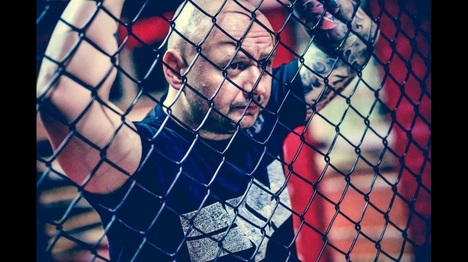
Any closing words or ideas you would like to share bro?
Thanks for your time. I hope you didn’t waste it reading my answers. In fact, I’m really confused that you asked me. Among our family I stay in one of the last rows rather. Big respect!
The respect is mutual brother. It was a pleasure speaking with you and capturing some of your ideas. I hope this interview will stimulate discussion amongst our community, or better still, inspire people to action. To be honest we could talk about much more, but I know you are a man of action rather than words and you were already a little uncomfortable agreeing to this in the first place. Thanks very much for taking part and for dropping some valuable gems on us.
Best of luck in your rapidly escalating career and thanks for always representing our family with pride.
BT
Thanks for your time. I hope you didn’t waste it reading my answers. In fact, I’m really confused that you asked me. Among our family I stay in one of the last rows rather. Big respect!
The respect is mutual brother. It was a pleasure speaking with you and capturing some of your ideas. I hope this interview will stimulate discussion amongst our community, or better still, inspire people to action. To be honest we could talk about much more, but I know you are a man of action rather than words and you were already a little uncomfortable agreeing to this in the first place. Thanks very much for taking part and for dropping some valuable gems on us.
Best of luck in your rapidly escalating career and thanks for always representing our family with pride.
BT
